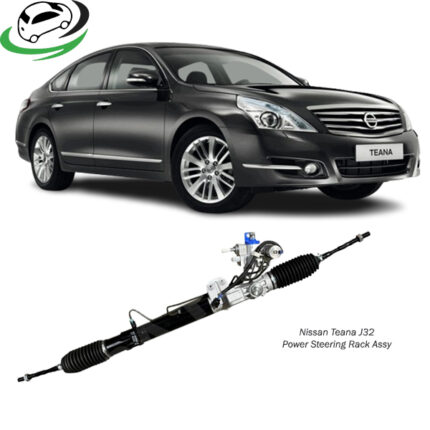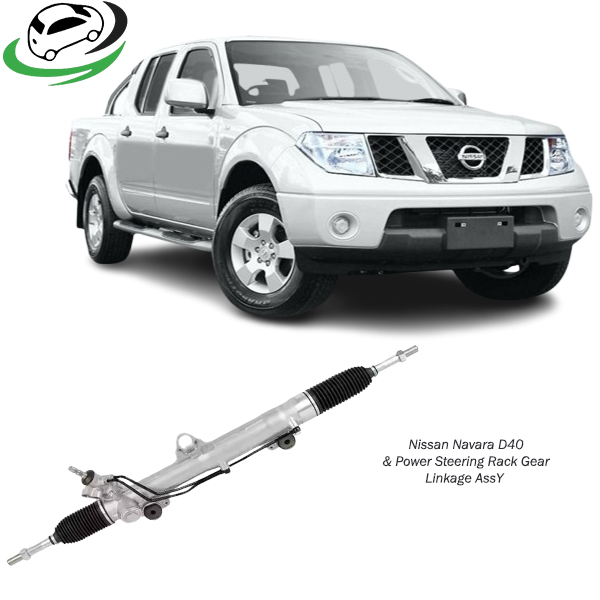-3%
Get Nissan Navara D40 Power Steering Rack Gear & Linkage Assy 49200-AE020 in Kenya
The Power Steering Rack Gear & Linkage Assembly is a crucial component in modern vehicles, responsible for translating the driver’s steering wheel movements into the car’s wheels, allowing for efficient and smooth directional changes. It’s a key part of the power steering system, which reduces the effort needed to steer, especially at lower speeds. This assembly includes the steering rack, pinion gear, and linkage mechanisms that connect to the wheels. Understanding its function, construction, and maintenance can help you appreciate its role in vehicle safety and control. Here’s a detailed look at the Power Steering Rack Gear & Linkage Assembly, covering its functions, benefits, common problems, and maintenance tips.
1. Function of Power Steering Rack Gear & Linkage Assembly
The primary function of the Power Steering Rack Gear & Linkage Assembly is to transfer the rotation of the steering wheel into lateral movement of the wheels, allowing the vehicle to turn in the desired direction. It does this through the following steps:
- Steering Input: When the driver turns the steering wheel, the steering column transfers this rotational movement down to the pinion gear.
- Gear Mechanism: The pinion gear at the end of the column engages with the rack gear, a straight, toothed bar. The rotation of the pinion causes the rack to move laterally (side to side).
- Linkage Assembly: This lateral movement is transmitted through tie rods, part of the linkage assembly, which connect the rack to the steering knuckles attached to each front wheel. These knuckles control the wheel’s position, angle, and responsiveness to the driver’s commands.
- Hydraulic or Electric Assistance: Modern power steering systems incorporate either hydraulic pumps or electric motors to assist in turning. Hydraulic systems use pressurized fluid, while electric systems use electric motors to add force, reducing the physical effort needed to steer.
Together, these components work to ensure that turning the steering wheel translates directly and seamlessly into controlled movement of the vehicle’s wheels.
2. Components of the Power Steering Rack Gear & Linkage Assembly
The Power Steering Rack Gear & Linkage Assembly is made up of several main parts:
- Steering Rack: The rack is a long metal bar with teeth that mesh with the pinion gear. It moves side to side within a casing, connected to the steering knuckles through tie rods.
- Pinion Gear: Attached to the steering shaft, the pinion is a small gear that engages with the rack gear to convert rotational motion into lateral movement.
- Tie Rods: These connect the rack to the steering knuckles on each side. They have inner and outer sections to allow for steering adjustment and flexibility.
- Seals and Bushings: These ensure smooth operation, reducing friction and wear, and keep the hydraulic fluid (in hydraulic systems) contained.
- Power Steering Pump (in hydraulic systems): Driven by the engine, this pump provides hydraulic pressure, helping to turn the wheels more easily.
- Electric Motor (in electric power steering systems): Replacing the hydraulic pump, the motor provides electric assistance for steering.
Each component is designed to endure significant force and wear, making strong, durable materials essential for the assembly’s longevity.
3. Types of Power Steering Systems
The Power Steering Rack Gear & Linkage Assembly is integrated into different power steering systems, primarily hydraulic power steering (HPS) and electric power steering (EPS). Each has unique benefits and components:
- Hydraulic Power Steering (HPS): In HPS, the power steering pump provides hydraulic pressure that assists in moving the steering rack. It typically requires a belt-driven pump connected to the engine. This system is known for its smooth and natural steering feel but is less efficient as it always draws power from the engine.
- Electric Power Steering (EPS): EPS systems use an electric motor for assistance, making them more energy-efficient and reducing the engine load. They allow for more customized steering responses and are commonly found in newer vehicles.
4. Benefits of Power Steering Rack Gear & Linkage Assembly
The assembly brings numerous advantages to vehicle performance, handling, and safety:
- Enhanced Control: By reducing the physical effort required, the power steering rack and linkage allow for more precise and responsive control, especially during complex maneuvers or at low speeds.
- Improved Comfort: The steering is smoother, which minimizes driver fatigue, especially during long trips or in city driving with frequent turns.
- Better Road Safety: With quicker and easier steering responses, the driver can make rapid adjustments to avoid obstacles or navigate challenging road conditions.
- Reduced Wear on Other Components: By handling the force needed for steering, this assembly reduces the stress on other steering components, which helps extend the lifespan of the overall steering system.
5. Common Problems with Power Steering Rack Gear & Linkage Assembly
Over time, wear and tear can lead to various issues in the Power Steering Rack Gear & Linkage Assembly:
- Leakage: In hydraulic systems, fluid leaks are common due to worn seals, damaged hoses, or a failing pump. Low fluid levels reduce hydraulic pressure, making steering harder.
- Excessive Play: If there’s too much play in the steering wheel, it may mean the tie rods or internal parts of the rack are worn, leading to reduced steering precision.
- Noisy Operation: Knocking, squeaking, or whining sounds when steering may indicate damaged bushings, insufficient lubrication, or failing components in the linkage.
- Stiff Steering: Hard or stiff steering can stem from fluid leaks, low power steering fluid, or an electric motor issue in EPS systems. This increases steering difficulty and can compromise safety.
- Uneven Steering Response: If steering is inconsistent, with certain areas feeling harder or easier to turn, it may be due to worn teeth in the rack or a damaged pinion.
6. Maintenance and Care Tips
Proper maintenance of the Power Steering Rack Gear & Linkage Assembly extends its lifespan and ensures reliable steering performance:
- Regular Fluid Checks: For hydraulic systems, check and maintain adequate power steering fluid levels. Replace old fluid to prevent buildup that can cause blockages and leaks.
- Inspect for Leaks: Regularly inspect the area around the steering rack for signs of fluid leakage, especially around the seals and hoses.
- Check Tie Rod Ends and Bushings: These components wear over time, affecting steering responsiveness. Replace worn tie rods and bushings to maintain control and reduce vibrations.
- Listen for Unusual Sounds: Squeaks, knocks, or whining sounds when steering may indicate worn or damaged components that need repair.
- Get Regular Alignments: Misalignment puts strain on the steering linkage, causing uneven wear. Regular wheel alignments prevent excess stress and ensure smooth handling.
- Avoid Holding the Steering at Full Lock: Holding the steering wheel fully turned for long periods can overheat the hydraulic pump, leading to premature wear.
7. Signs of Wear and When to Replace
Knowing when to replace parts of the Power Steering Rack Gear & Linkage Assembly is crucial for vehicle safety. Common signs of wear include:
- Difficulty Steering: Increased effort required to steer, often due to hydraulic leaks or a failing pump, is a sign that maintenance is required.
- Steering Drift: If the vehicle drifts to one side, even on a straight path, it may be due to wear in the rack or tie rods.
- Uneven Tire Wear: Misalignment due to worn linkage can cause tires to wear unevenly, reducing traction and safety.
- Vibrations in Steering Wheel: Vibrations, particularly at higher speeds, indicate that the linkage or bushings are likely worn.
Conclusion
The Power Steering Rack Gear & Linkage Assembly is a sophisticated system that transforms driver inputs into precise wheel movements, allowing for safe, controlled, and comfortable driving. Regular maintenance, including fluid checks, alignment, and part inspections, can significantly extend its lifespan and performance. Being proactive with care can help avoid common steering issues, maintain control, and provide a smoother driving experience overall. Whether in hydraulic or electric systems, this assembly remains a key component for efficient vehicle handling, safety, and the overall driving experience.
Follow us on Facebook for more parts.



